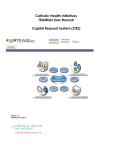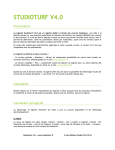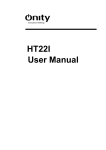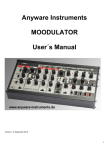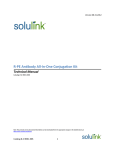Download THE MODEL PLAN: ITS IMPACT - Chapter 13 Trustee Home Page
Transcript
★ February 2002 Volume I, Number 2 THE MODEL PLAN: ITS IMPACT On August 1st, 2001, a collaboration of bankruptcy judges entered a standing order requiring the model plan to be used for all Chapter 13 cases filed in the Northern District of Illinois. More importantly, since that time the court has only confirmed cases with the model plan and has denied confirmation on any other plans. As the Chapter 13 liaison, Judge Wedoff was instrumental in developing a format for the model plan that would provide clear information to ease administration as well as allow flexibility in plan design. Since August, there have been a number of updated plans to correct perceived technical housekeeping issues. The latest version was implemented February 1st, 2002. This new version allows the trustee to pay the lesser of the amount specified in the plan or a lower actual amount if consented to by the creditor. Judge Wedoff continues to gather comments and concerns from the bankruptcy community through his presentations on the model plan so that everyone’s concerns can be addressed. This is very important as its impact can be felt by everyone involved in the Chapter 13 bankruptcy process. In order to understand this impact more clearly, our entire office participated in a model plan seminar on January 25th, 2002. Anthony Olivadoti and Jay Tribou were the presenters, discussing the basics of understanding and interpreting the model plan. As we learned in our seminar, the model plan has dramatically altered the trustee’s administration of cases. One of the largest changes in the plan is that now the terms of the confirmed model plan dictate which claims and what amounts the trustee must pay. With prior plans, the creditor proof of claim did this solely. However under the model plan format, secured creditors are actually no longer required to file claims. As the trustee, we now create claims for scheduled secured creditors who are provided for in the plan and disburse to those corresponding addresses listed on schedule D regardless of whether a proof of claim is on file. This one change makes it critical that both the debtor and his attorney provide our office with accurate information. Although they have always had the responsibility of listing all creditors, their addresses, account numbers, and the proper claim amounts, the consequences of making errors are greater with the model plan. Creditors that are not specifically provided for in the model plan will not and do not get paid. Furthermore, correct addresses and account numbers enable the trustee to efficiently disburse and limit the creditor delay in posting payments due to insufficient identification. Account numbers also help the trustee properly track changes. For example, without proper noticing when other companies buy out debts or switch servicers, the presence of an account number eases the research necessary on the trustee’s part to continue on in disbursement. In addition, debtors’ attorneys must fill in the appropriate boxes throughout the plan. If boxes are not checked, they are inapplicable and will hinder the debtors’ true desires. Attorneys need to carefully review plans before filing them. Many of the errors we find are obvious and are most likely due to oversight. For example, although any debt listed on schedule D must be provided for in the plan, See Model Plan: Its Impact, page 2 February 2002 Volume I, Number 2 Model Plan: Its Impact (continued from page 1) debtor attorneys frequently fail to use schedule G for items they wish to pay directly or surrender. Such errors need and should be avoided at all costs. Most of the errors made require amendments and will delay confirmation of the plan. The role of the creditor has also been transformed with the model plan. If the court confirms a properly noticed plan, that plan binds the creditor. This means the amount listed by the debtor as owed to the creditor is the amount that the creditor will get paid. As a result, creditors have started filing many more objections before the court confirms a plan. This way the discrepancy between what the debtor listed and the creditor proof of claim is resolved. The higher volume of objections has led to a longer average to the time needed to get a case confirmed. This time increase has impacted the court calendars because more cases are being held up pending resolutions to creditor objections. In fact, it is now unusual for cases with mortgages or cars to get confirmed on their first time up for confirmation. Hopefully, as the creditors continue to work with the model plan, they will be able to provide debtors with better estimates on debt amounts before the case is filed. This will help streamline the confirmation process. What is the Lockbox? We frequently tell debtors, "Please send your payment to the lockbox." It will make more sense to them if we explain what a lockbox is because the average person has probably never heard the term before. The lockbox is very much like a post office that’s located at our bank. As a matter of fact, the zip code, 60674, is exclusive to LaSalle Bank. Any piece of mail with the zip code 60674 goes directly to the LaSalle Bank lockbox. The matching department number and four digits on the end of the zip code tells the bank which of their clients should get the envelope. Ultimately with a properly prepared model plan, the administration is easier. The key questions to administering a plan are simply: who do we pay, who don’t we pay, and if we do pay, how much. The model plan answers that. With the model plan, creditors, the trustees and the courts are better able to understand the debtors’ intentions. Because the lockbox functions like a post office box, it’s very important that payments not be sent by courier, messenger, or walked into the bank. When an envelope is mailed to the lockbox it is processed immediately. However, when an envelope is sent to the lockbox using a method that requires a signature, the envelope must be handled differently and the processing of the payment is delayed. Kimberly Eisenberg and Anthony Olivadoti The Marshall Chronicles The Editorial Staff: It is especially important that debtors not attempt to make their payments at LaSalle Bank at 135 S. LaSalle. The tellers at LaSalle Bank have been instructed not to accept walk-in payments for deposit to our account. If for some reason the teller does take the payment, it can often take days for that payment to reach the lockbox area to be processed. Amanu Nwaomah, Cheryl Jones, Shanika Thomas, Santricia Teat, Karen Barron, Nicole Robertson, Joanne Coshonis, Robin Dirksen and Dave Latz Contents and Contributors: The Model Plan: Its Impact, pg. 1....Kimberly Eisenberg & Anthony Olivadoti What Is The Lockbox?, pg. 2.........................Nicole Robertson Trustee Matters, pg. 3...............................Marilyn O. Marshall Debtor Welcome Letter, pg. 3..............................Sandra Pillar Congratulations Are In Order, pg. 4...................Robin Dirksen African American History Month, pg. 4.......Amanu Nwaomah A LaSalle Bank Policy Change, pg. 5 ..................Rita Saunders Converted Cases, pg. 5.............................Angela Hope-Davis The Oldest Bankruptcy Filer, pg. 5.......................Allison Blum The Identities Challenge, pg. 5..................Elva Valdivia-Lynch Employee Recognition Committee, pg. 6.............Juliana Jones African American History Quiz , pg. 8..........Amanu Nwaomah We should always ask the debtors to (1) write their name and case number on the payment, (2) make the check payable to: Office of the Chapter 13 Trustee, and (3) pay in the form of a money order or cashier’s check. Please take an extra moment on a client services call, or during the creditors meeting, to explain the process to our debtors so that their plan payments may be processed efficiently and correctly. Nicole Robertson 2 February 2002 Volume I, Number 2 Trustee Matters §341 MEETINGS In reading my appointment from the U. S. Trustee, Ira Bodenstein, it specifically stated, “You are designated to be the presiding officer at the §341(a) meeting and have the authority to examine debtors under oath.” This is one of the most important responsibilities I have as Trustee. Therefore, all of those whom I have designated to serve in my stead must also realize the importance of the §341 meetings and make every effort to follow the provisions of the Standing Trustee Handbook and General Requirements of Chapter 5, and Appendix C which were updated effective December 17th, 2001. The Trustee, attorneys and hearing officers must recommit ourselves to serving the bankruptcy community and providing the debtor, debtor’s attorney, and creditor’s attorney, the service to which all are entitled once they enter our doors. NACTT MID-YEAR MEETING The winter meeting in Washington D. C. was everything everyone said it would be. All work, no play, substantive issues and an agenda which addressed Information Technology, Electronic Case Filing and Debtor Identification at the §341(a) Meetings. Information Technology (IT) systems are a critical part of the operation of the standing trustee’s office. Yes, our software (CaseNET) is different from everyone else’s in the world, but we will stay on the cutting edge of technology and have security controls in place. I will ensure that adequate controls are established to protect the information technology assets in the office. ORGANIZATIONAL DIAGNOSTICS As each of you are aware, Kerry and Paul Carson of Organizational Diagnostics will return to our office on March 15th, 2002, to conduct a workshop with the staff. Additionally, training will be offered to those of you who conduct performance appraisals. I am committed to promoting fairness and equity in our compensation. I think the study was performed at the most appropriate time. I salute the staff for supporting the study. The staff’s desire to understand the study and the total concept of promoting equity in the workplace will assist in our successful use of the results of the study. I will meet with each of you individually prior to March 15th, 2002, to discuss your current wage class. Marilyn O. Marshall ELECTRONIC CASE FILING IS COMING TO A COURT NEAR YOU was the heading of the handout. Our court is scheduled for March, 2003. This will give me ample time to meet with the new Clerk of Court, Ken Gardner, who has used Electronic Case Filing in San Diego prior to his arrival in Chicago. As always, my biggest concern is the ECF hardware and software requirements. I will establish a task force to start assessing our abilities and capabilities to participate in Electronic Case Filing. Debtor Welcome Letter Ms. Marshall is introducing a new letter that will support her goal of increasing communication in the bankruptcy community. It is called the Debtor Welcome Letter. The letter is set for its inaugural mailing March 1st. Every debtor filing a new case with our office will receive this welcome letter. It will inform them of their §341 meeting date and time, directions to our office, their attorney’s name/phone number and their payment information. Rosalind’s team will be responsible for mailing the letter. You will see a new field displayed in CaseNET on the plan tab stating the date the letter was mailed. Working on the Debtor Welcome Letter has been a great example of teamwork. Eileen collected examples for Ms. Marshall who drafted the letter. Robin info-mapped the information on Microsoft Word. Cliff programmed the job in CaseNET and Dave took the data from Cliff’s job to create a Microsoft Word mail merge document. I will be documenting the process as part of our CaseNET user’s manual. Look for more details in the weeks to come. Hats off to Dave and Cliff! Sandra Pillar 3 February 2002 Volume I, Number 2 Congratulations Are In Order Walk & Roll The 30th Anniversary American Cancer Society Walk & Roll will be Sunday, May 19th, 2002. Mark your calendar and join the Chapter 13 Trustee Team. Congratulations are in order to Cheryl Jones, whose employment status has changed from part-time to full-time effective Monday, February 11th, 2002. Cheryl began part-time employment in November, 2000, as a case administrator. She was hired to assist the confirmation staff during a period when three paralegals were out on leave. Her responsibilities include the processing of amendments, generation of financial summaries and motions to dismiss, and preparation of payroll letters on closed, completed, and converted cases. Cheryl also processes original documents, and aids our attorneys with creditor disbursement return correspondence. She is also the featured article liaison for the newsletter committee. Cheryl is not a newcomer to the Office of the Chapter 13 Trustee. She was formerly hired in August of 1987 as a full-time receptionist. During those years, her career progressed from receptionist to receipts entry to financial administrator and then on to bankruptcy case administrator. She terminated her employment in February of 1998 to fully commit time to raising her daughter, Amber, who is now three. She also has a twelve year old son, Quinté. She is married to Henry, a supervisor at Northwestern University and member of a popular 16-piece band, Gentlemen of Leisure. When Amber became two, Cheryl felt the need for her to interact with children her own age and made preparations to put her in a structured day care program. This allowed Cheryl time to prepare herself to return to the work force. Because she has always maintained contact with members of our staff, Cheryl was able to offer her services when she heard of our staff shortage. She was a welcomed addition. Cheryl is looking forward to her future here at the Office of the Chapter 13 Trustee and we are happy to have her back on board full-time. Robin Dirksen We’re looking for a team coordinator. Anyone interested in the position should contact Rita Saunders. African American History Month: How it Evolved and Why We Continue to Celebrate It. With the efforts of the historian and educator, Dr. Carter G. Woodson, the first celebration of black history began in the early 1900s. Woodson promoted the study of black history first through the Association for the Study of Negro Life and History which he founded in 1915 and later through the Journal of Negro History which he began in 1916. Negro History Week was celebrated for the first time in 1926 during the second week in February. Black history had been largely left out of the history books and this week encouraged Americans to learn about a rich history they could not read in the mainstream books. February was chosen because Frederick Douglas and Abraham Lincoln, two important figures that greatly impacted African American history, celebrate their birthdays during this month. Not until 1976 did Negro History Week became African American History Month. With this transition, Americans began to honor and learn about the achievements and rich history of African Americans during the entire month. And though many years have passed, the original need and purpose of this celebration has not subsided. African American History Month is a time for reflection. We all must know our past, the good and the bad, so that its life lessons can be revealed. Don’t let Black History Month pass without taking away something new! Would You Like to Move Up the Career Ladder? Amanu Nwaomah We’re happy to announce two position vacancies in our trusteeship: Case Administrator I (Confirmation) and Case Administrator I (Claims). Details about the openings are posted in the Café Pro Se and also on the bulletin boards outside the library and the training room. Qualified candidates must submit a current resume and cover letter to the human resources administrator before the end of the posting period. Details regarding the selection and interview process will be provided at a later date. 4 February 2002 Volume I, Number 2 A LaSalle Bank Policy Change A New Office Record For The Oldest Bankruptcy Filer Debtor Refunds – As a courtesy, LaSalle Bank will cash debtor refunds even if the debtor does not have an account with them. Effective immediately, they are changing their policy on refunds over $3,000.00. Our bank representative must approve these. If you receive any calls from debtors trying to cash refunds of over $3,000.00 at LaSalle, please refer the caller to Patti Brower. In Patti’s absence, refer the caller to Rita Saunders. On January 28th, 2002, staff member Allison Blum held a creditors’ meeting with our oldest bankruptcy filer yet. He was born in 1902 and recently celebrated his 100th birthday. The gentleman, amazingly, still owns and directs a funeral home. According to him, his wit and charm are still as sharp as they were when he was in his 70’s. As was his strength, which he illustrated by leaping across the table to clutch the microphone for his bankruptcy debut interview. He is doing well and intends on completing his sixtymonth payment plan. Allison Blum And, unrelated but of note, January Creditor Disbursements totaled $2,519,270.03, and the Closing Team audited 99 cases in January. Rita Saunders The Identities Challenge FYI – Our biggest challenge with Identities (creditor’s addresses) is the ongoing maintenance. Please be careful when adding new/additional addresses or identities to our database. Converted Cases A converted case is a case that was originally filed as one form of bankruptcy but converts to another. Our office specifically deals with Chapter 13 cases that convert to a Chapter 7 or vice versa. Here are some tips: Every month we receive from the Bankruptcy Court an average of 60 cases that convert from a Chapter 13 case to a Chapter 7 case. The information that the court provides includes the case number, the debtor’s name, the Chapter 7 Trustee, and the §341 meeting date and time. 1. Be thorough in searching for the address you need. 2. Do not add an identity solely to match the exact creditor name. For example, if the identity you are looking for is Discover Card and you only see Discover Financial, check for the address in that identity and use it if found. If it is not found, do not add Discover Card as a new identity, simply add the address to the existing Discover Financial. Our office then sends a copy of the petition and any amended schedules to the Chapter 7 Trustee. This information is sent at least two weeks before the §341 meeting date. This time frame provides the Chapter 7 attorney the opportunity to review the case before the §341 meeting is held. After having posted the documents to the Chapter 7 Trustee, a docket entry is made in CaseNET recording the sending of the information. Elva Valdivia-Lynch Just For The Fun Of It If anyone receives a call about a converted case or if you need additional information, please ask Estela or Angela. "Then along came the first Electrical Pioneer, Benjamin Franklin, who flew a kite in a lightning storm and received a serious electrical shock. This proved that lightning was powered by the same force as carpets, but it also damaged Franklin's brain so severely that he started speaking only in incomprehensible maxims, such as 'A penny saved is a penny earned.' Eventually he had to be given a job running the post office." Angela Hope-Davis ➜ Dave Barry, "What is Electricity?" 5 February 2002 Volume I, Number 2 How to Clean Your Mouse A Few Words From the Employee Recognition Committee If you’ve noticed that you are not getting the response you are used to from your computer equipment, the problem may be as simple as your mouse. From time to time, it is important to give your mouse a good cleaning. It may seem complicated, but it is really a simple task. Guess what? The Employee of the Month has been selected. You’ll find out who’s been selected in the March Issue. The Employee Recognition Committee is looking for Chapter 13 Humanitarians. If you have done a Humanitarian Service, please let the Chairperson know. Start by turning off your computer and unplug the mouse. When you turn the mouse over, you will see a "locking ring." This holds the mouse ball in place. You will unlock the ring in the direction of the arrows. It may take some gentle pressure to get the ring to begin moving. Once the ring is removed, you can take out the mouse ball itself. Using a soft, lint-free cloth, gently clean the ball. If it is particularly dirty or sticky, you can run it under warm soapy water and then use the cloth to clean it. Set aside and allow to air dry. Criteria for the Time and Attendance Award This award will be presented every six months. The criteria are: You cannot have any missed punches on your time record, no tardiness, no unanticipated absences and no exceptions on the exception report. The reward will be $50, one vacation day added to your leave balance and a certificate of accomplishment. Good Luck! Juliana Jones Next you will need to clean the rollers located inside the mouse. You will probably see some lint and fiber buildup on the rollers themselves. Using your fingernail or a thin, stiff piece of cardboard, gently scrape along the rollers to dislodge this material. If the rollers are particularly dirty, you can use a cotton swap dipped lightly in rubbing alcohol to clean them. To remove any material from inside the mouse, use a can of compressed air. Do not hold the can upside down. Quickly spray the inside of the mouse to dislodge any particles inside. Congratulations, We Have a New Mother! It’s a girl! Agueda Orozco had a 6 lb. 11 oz. baby girl on Friday, February 15th at 7 pm. Her name is Yaltseli. Both mother and baby are doing fine. Yaltseli came into this world as a bit of a surprise to her family and our office. Especially our office, given the fact we were in the mist of giving mother Agueda her baby shower when she went into labor. But we made a little delivery of our own. On Saturday Elva delivered the gifts and cake to Agueda’s home where her sister was there to receive them. Agueda is very thankful for the gifts. In particular, a gift of diapers from Angela were a favorite and quite handy. Since Yaltseli came a bit early, they hadn’t bought any diapers yet. Once all the components of your mouse are dry, replace the ball and the locking ring. Plug the mouse back in and restart your computer. You should notice an immediate improvement in the response of your cursor on the screen. Repeat this cleaning process about once a month or whenever you are having problems with smooth movement of the cursor. March Birthdays, Service Anniversaries and Other Notable Dates All Staff Meeting on March 1st. Happy Birthday to Karen Barron on March 8th! Happy Birthday to Nicole Robertson on March 9th! Happy 6th Anniversary to Darlene Odom on March 11th! St. Patrick's Day on March 17th! Spring begins on March 20th! Happy 4th Anniversary to Kim Eisenberg on March 23th! Happy 4th Anniversary to Santricia Teat on March 25th! Happy Birthday to Sandra Pillar on March 27th! 1st Day of Passover on March 28th. Good Friday on March 29th. Easter Sunday on March 31st. Even though Agueda wasn’t there, a good time was had by all! 6 February 2002 Volume I, Number 1 Your Newsletter Committee: Ready to Serve Name: Karen Barron Office Position: Paralegal Newsletter Position: Departmental Highlights Liaison Why did you join the committee? Because I’m ecstatic about the office taking a proactive attitude with employee involvement. I want to be a part of something that gives employees a voice. What will be your special contribution to the newsletter? My flexibility, whatever I can do to help just let me know. We just wanted to introduce ourselves. In the coming year, we hope to provide you with informative details about the on goings of the Office of the Chapter 13 Trustee. So without any further delay, here we go… Name: Amanu Nwaomah Office Position: Paralegal Newsletter Position: Editor-in-Chief Why did you join the committee? Well, we all know how I have lots of energy. So I figured, this would be a good outlet. Besides, I love to talk. What will be your special contribu tion to the newsletter? My innovative ideas, strong organization skills, and my keen eye on issues. Name: Nicole Robertson Office Position: Receipts Manager Newsletter Position: Marshall Matters Liaison Why did you join the newsletter committee? I tend to associate with the same people in the office all the time. I thought working on the committee would be a great way to get to know more of my co-workers. What will be your special contribution to the newsletter? Apple Pie. Name: Cheryl Jones Office Position: Case Administrator Newsletter Position: Featured Article Liaison Why did you join the committee? Because I enjoy interviewing people, compiling information, and producing well-written articles. What will be your special contribu tion to the newsletter? My contributions to the newsletter are my ideas, proof-reading, and typing skills. Name: Santricia Teat (Sandy) Office Position: Case Administrator / Confirmation Newsletter Position: Employee of the Month Liaison Why did you join the newsletter committee? Because I would like to see many people in the office recognized for all the great things they do within the office. What will be your special contribution to the newsletter? My special contribution is laughter, because it’s good to the soul just like medicine. Name: Dave Latz Office Position: Operations Coordinator Newsletter Position: Design & Layout Why did you join the committee? I felt I had some expertise to contribute, since I also worked on the newsletter for the Jack McCullough trusteeship. What will be your special contribu tion to the newsletter? My knowledge of the design and production processes involved in producing an office newsletter. Name: Shanika Thomas Office Position: Case Administrator / Auditor Newsletter Position: Look Who’s Talkin’ Liaison Why did you join the newsletter committee? Because I have a keen mind and great ideas. What will be your special contribu tion to the newsletter? My spur of the moment ideas which happen to be very good. Name: Joanne Coshonis Office Position: Senior Attorney Newsletter Position: Human Resources Update Liaison Why did you join the committee? To inform our staff as well as affiliate offices about areas of interests and concern that affect us and impact others. What will be your special contribution to the newsletter? Communications skills. We hope you all enjoyed our first two editions and look forward to more. We are here to answer any questions and to field your suggestions. 7 February 2002 Volume I, Number 2 Newsletter F Y I s If you would like to contact us or submit ideas or articles for the newsletter, you can do so by: ✓ e-mailing us at [email protected] ✓ ✓ dropping your submission or idea in the anonymous newsletter folder located in the mail room, or leaving them with Amanu Please remember when making a submission to the newsletter, it must be: ✓ type-written and ✓ submitted by the 3rd Wednesday of the month via e-mail, a Word document or an ASCII file and ✓ submitted to the appropriate committee member (see the article inside) We also ask that anyone who goes to a seminar please be prepared to furnish the committee with a detailed article on its subject. You may also view this edition of the Chronicle and previous issues on the Chapter 13 Trustee website at http://www.chicago13.com/. ★ Office of the Chapter 13 Trustee Marilyn O. Marshall 224 S Michigan Ave ✩ Ste 800 ✩ Chicago IL 60604-2500 African American History Quiz 4. What major legal decision affecting civil rights was handed down in 1954? A. Brown vs. Board of Education B. Civil Rights Act C. Voting Rights Act D. 24th Amendment Eliminating Polling Tax 1. What period of time is commonly referred to as the civil rights period? A. 1883 – 1901 B. 1920s C. 1954 – 1965 D. 1960s 2. When was the Montgomery bus boycott and who was the central person? A. 1962, H. Rap Brown B. 1922, W.E.B. DuBois C. 1870, Hiram R. Revels D. 1955, Rosa Parks 5. The Little Rock Nine was a group who: A. Sat in at lunch counters B. Demonstrated for fair housing C. Disrupted the Democratic Convention in 1962 D. Integrated Central High 3. To what city did the Selma march go? A. Montgomery B. Jackson C. Birmingham D. Atlanta 8











